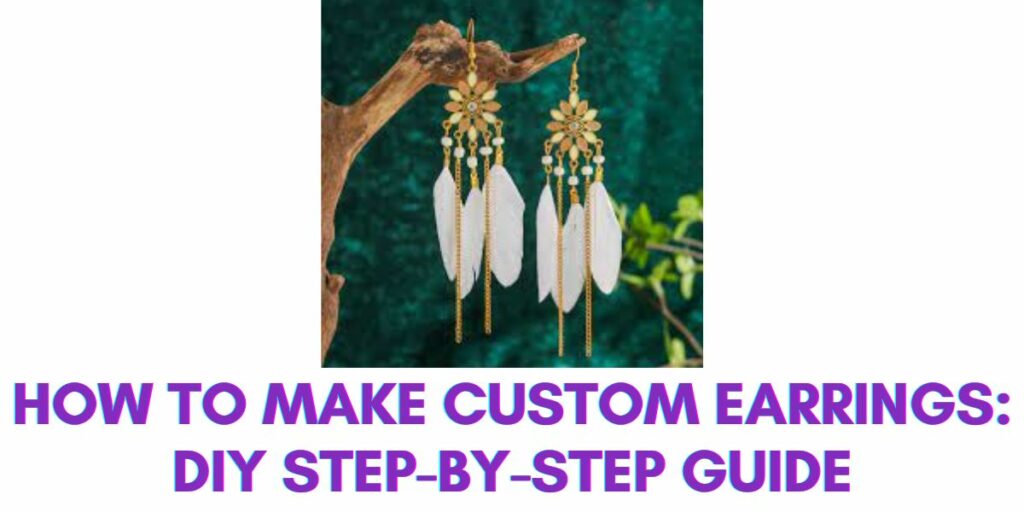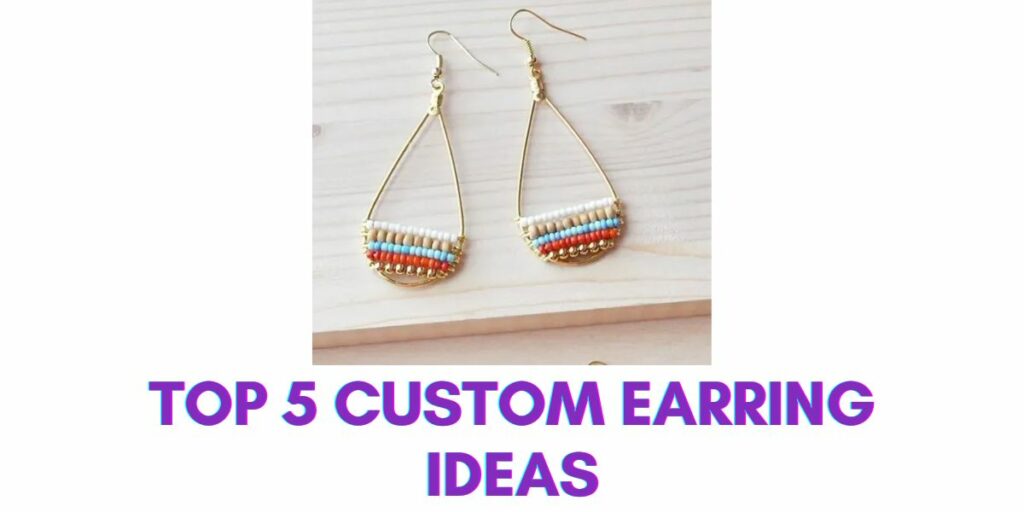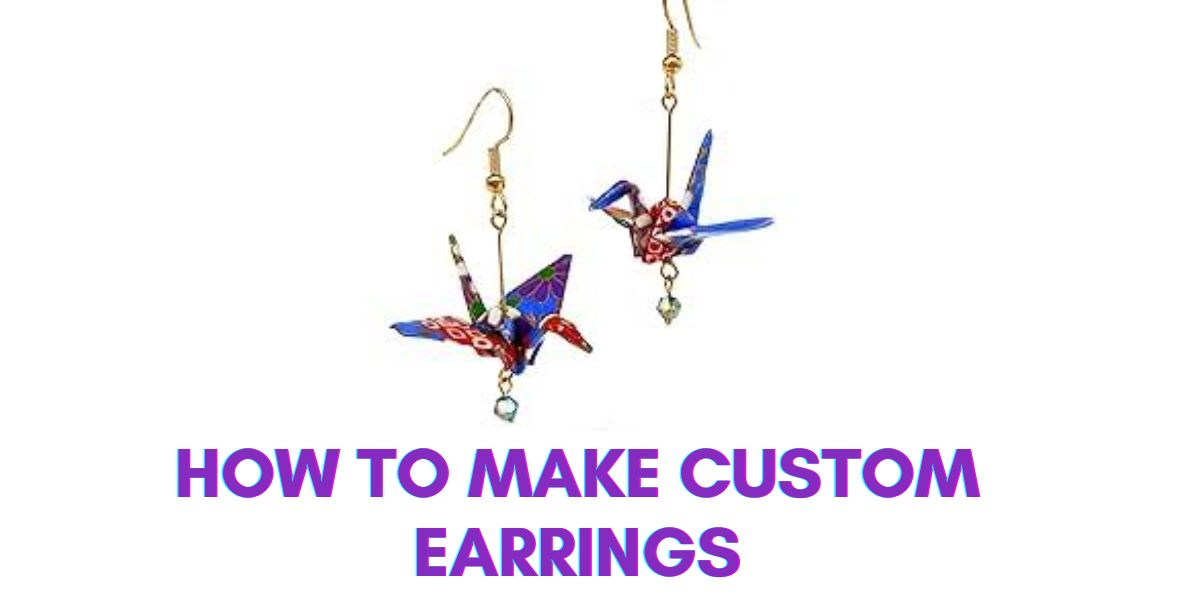I remember the first time I tried making my own earrings.
It started with a few beads, some wire, and a big idea.
At first, it was just for fun, but soon, I found out how awesome it is to make something all by myself.
If you’re new to this or already love crafting, I’m excited to show you how.
In this easy-to-follow guide, I explain How to Make Custom Earrings, ensuring that each piece you create isn’t just jewelry but a reflection of your unique style.
How to Make Custom Earrings: DIY Step-by-Step Guide

Follow these steps to make custom earrings:
- Planning Your Design: Begin by sketching your earring design. Consider factors such as style, desired length, and the strategic placement of beads or charms.
- Gather Material: Gather all the necessary materials and tools for your design, ensuring you have an ample supply of wire and beads for creating the envisioned pair of earrings.
- Wire Cutting: Cut the wire to your desired length, considering your design and the overall earring length.
- Creating the Earring Base: If opting for wire as the base, shape it according to your design using needle-nose pliers.
- Adding Beads or Charms: String beads or charms onto the wire, experimenting with various arrangements until you achieve the desired aesthetic for your custom earrings.
- Securing Beads and Elements: Use pliers to secure the loops at the ends of the wire, ensuring beads or charms are tightly wrapped to prevent movement or displacement.
- Attaching Findings: If your design includes earring hooks or studs, attach them to the created loops. Alternatively, if using findings like jump rings or crimps, secure them in place using pliers.
- Personalizing (Optional): Infuse a personal touch into your creation by adding elements such as initials or birthstones.
- Ensuring Symmetry: Lay the earrings side by side to verify symmetry. Make necessary adjustments to achieve a balanced and appealing look.
- Finalizing Touches: Carefully trim any excess wire with wire cutters, ensuring a neat and polished finish.
Explore our guide on what necklaces to wear with hoop earrings to discover the perfect necklace to match your style.
Materials and Tools Needed
These are the materials and tools needed to make custom earrings:
- Earring Hooks or Studs: These are the foundational components for your earrings, providing the attachment point to the earlobe.
- Wire (Various Gauges): Get wire in different thicknesses based on your design. Thicker wire is strong and good for structure; thinner wire is great for details. The wire serves as the framework for your custom earrings.
- Beads, Gemstones, or Charms: Select a diverse array of beads, gemstones, or charms to add texture, color, and personality to your earrings.
- Pliers: These are used for gripping and bending wire with precision. They are also used for cleanly and accurately cutting wire to your desired lengths, preventing fraying or uneven edges.
- Crimps: Small metal pieces used to secure the ends of the wire, preventing beads from sliding off.
- Elements like Initials or Birthstones: You can use initials, engraved charms or wirework, and birthstones to personalize your earrings, adding a meaningful touch.
If you are thinking of making them for double piercings, check out this post first, where I discuss if Double Pierced Ears Out of Style.
How to Make Custom Earrings: Basic Techniques
These are the basic techniques for making custom earrings:
- Wire Wrapping: Use wire to create intricate designs, wraps, and loops. This versatile technique allows secure connections of beads, gemstones, or other elements.
- Bead Stringing: String beads onto a flexible wire or thread to craft simple and elegant designs. Ideal for lightweight and colorful earrings.
- Wire Bending: Shape wire into various forms, including geometric shapes, swirls, and decorative elements, to fashion unique designs.
- Metal Stamping: Stamp or engrave metal components with letters, numbers, or designs to add a personalized touch to your earrings.
- Resin Casting: Embed small objects like flowers or glitter in resin for personalized and eye-catching earrings. This technique offers endless creative possibilities.
- Clay Modeling: Sculpt custom shapes or miniature figurines using polymer clay. Once baked, the clay becomes a durable and lightweight material.
- Macramé Knotting: Apply knotting techniques to create intricate patterns using a cord or thread. Ideal for bohemian or tribal-inspired earring designs.
- Loom Beading: Utilize a beading loom to create woven patterns with seed beads. This precise technique allows for intricate and detailed earring designs.
- Chainmaille Weaving: Connect small metal rings in various patterns to create chainmaille designs. This technique is perfect for crafting bold and textured statement earrings.
- Wire Coiling: Coil wire into spirals or other shapes to add texture and visual interest to your designs, often used for creating focal points.
- Earring Reshaping: Modify pre-made components or vintage earrings by reshaping, adding elements, or combining them to create entirely new designs.
Discover earring ideas for 2 holes, perfect for mixing and matching to enhance your fashion statement.
Top 5 Custom Earring Ideas

These are the top 5 custom earring ideas:
1. Initials or Birthstone Earrings
Craft earrings with charms that bear initials or birthstones, adding a distinct and sentimental touch to your jewelry collection.
2. Theme-Based Earrings
You can create earrings with a travel theme, design trendy ocean studs, create vintage chandelier earrings using lace and pearls, display nature in floral hoops, or try a futuristic style with sci-fi galaxy earcuffs.
3. Boho Feather Earrings
Combine feathers or turquoise beads with feather charms for colorful, free-spirited boho feather earrings.
4. Origami Crane Earrings
You can create elegant stud earrings featuring small origami paper cranes or design origami crane ear climbers with tiny cranes climbing the ear for a unique and eye-catching effect.
5. Nature-Inspired Earrings
You can design earrings delicately adorned with elements like acorns, mushrooms, florals, butterflies, or leaves.
How to Choose Your Custom Earring Design
Consider these things when selecting your custom earring design:
- Personal Style: Choose something that matches your personal taste and style preferences.
- Comfort: Prioritize comfort by selecting a comfortable design for extended wear, considering factors like weight and closure mechanisms.
- Face Shape: Consider your face shape, as different designs complement various face shapes differently.
- Metal Preferences: Choose a metal type that suits your skin tone and personal preferences, whether gold, silver, rose gold, or others.
- Gemstones or Beads: If incorporating gemstones or beads, choose ones that resonate with you or hold special meaning.
- Length and Size: Consider the length and size of the earrings, ensuring they fit well and complement your overall look.
- Versatility: Opt for a versatile design that can be dressed up or down for different occasions.
- Skill Level: If creating the earrings yourself, consider your skill level and choose a design that matches your abilities or challenges you to learn new techniques.
If you are three piercings and are looking to make DIY ones for them, refer to my Earring Ideas for 3 Holes guide.
FAQs on How to Make Custom Earrings
These are the most frequently asked questions on how to make custom earrings:
What Factors Should I Consider When Choosing Custom Earrings?
Consider your personal style, face shape, comfort, and the occasion for which you plan to wear the earrings.
Can I Customize Earrings to Include Specific Elements Like Initials or Birthstones?
Yes, you can add personal touches such as initials, birthstones, or specific materials.
How Do I Ensure the Earrings Are Comfortable for Extended Wear?
Choose lightweight materials, consider the earring closure type, and opt for designs that suit your comfort preferences.
What Materials Are Commonly Used in Custom Earring Designs?
Common materials include various metals (gold, silver, rose gold), gemstones, beads, pearls, and even unconventional materials like wood or fabric.
How Can I Incorporate a Theme Into My Custom Earrings?
Choose elements like charms, colors, or shapes representing a specific theme, such as travel, nature, or vintage romance, to infuse your earrings with a unique style.
Conclusion
Making custom earrings is about being creative and practical. You choose materials, add personal touches, and create unique accessories that show your style. I hope you now know how to make custom earrings by yourself.

